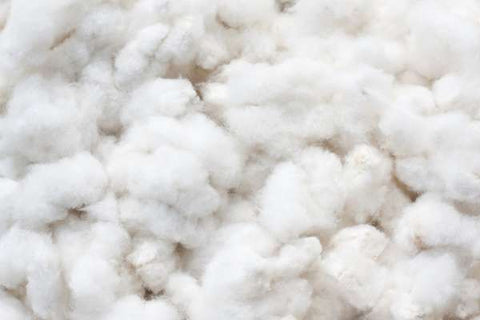By Denise Renee Grace and Irene Schmoller
Though I know summer is just around the corner, it is still chilly here and has been wet (which is actually lovely for this time of year), but soon it will be nice and warm hot. In anticipation for summer, I have been drawn to working with cotton. It is such a different experience to work with cotton fiber instead of something like wool. Cotton's staple length (average length of the individual fibers) is much shorter compared to most animal fibers. The first time I spun cotton, I felt like I had to learn how to spin all over again!
Now that I have practiced spinning cotton and understand that cotton needs a lot of twist to hold it together as a yarn, I love it! Because there is so much to learn, we are going to feature cotton this week and into next week. Cotton is available in many forms: organic, naturally colored, long staple pima, fluffy white acala, easy-to-dye and Easy-to-Spin Sliver; the list goes on.
So what are the basic spin-able forms of cotton on the market? I have found the main ones to be bolls, seed cotton, ginned cotton, puni, and sliver. You can find a selection of spinning cotton here.
Bolls
Bolls are great to learn how to spin cotton. It is the original form that comes right off of the plant with husk, seeds, and all. Bolls are also excellent for educational purposes and giving spinning demonstrations (check out our YouTube channel later this week for a video.) How many people have actually seen a real cotton boll?

Photo courtesy of Cotton Clouds
Seed Cotton
Seed cotton is cotton that has been separated from the boll husk but the seeds are still embedded in the fibers. This seed cotton is long staple pima; note that the seeds in the picture are "naked" (no fuzzy fibers adhering to them). The advantages of spinning "off the seed" is that the fibers have not been mechanically compromised in a gin.

Photo courtesy of Cotton Clouds
Ginned Cotton
Ginned cotton just has the seed taken out. The fibers are not arranged in any particular way and can easily be hand fluffed or carded to spin. You will notice that ginned pima cotton has a creamy color, longer staple fiber and is easier to spin. Acala cotton has a whiter color ideal for dyeing, a shorter staple but is fluffier and needs little or no hand carding.

Photo courtesy of Cotton Clouds
Punis
Punis are carded cotton, rolled (with a dowel) into a cylindrical shape similar to a wool rolag. While these are traditionally handmade in India, you can make your own! Punis are the best fiber preparation for spinning on a supported tahkli spindle.

Photo courtesy of Cotton Clouds
Sliver
Sliver is cotton that has been mechanically formed into a long continuous formation. Combed sliver has all the fibers parallel while carded cotton does not. Beginners should start with carded sliver. Combed sliver should be spun with the worsted method by experienced cotton spinners. The resulting yarn is soft and silky. Sliver cottons are idea for clothing and towels.
Cotton sliver loves to be dyed into a rainbow of colors that is fun to spin as you see subtle color changes form as you spin. This hand-dyed cotton sliver is from Chasing Rainbows Dyeworks. This is an ideal fiber preparation to spin for multicolored socks. We will explore more of these applications this week and into next week.

Photo courtesy of Chasing Rainbows Dyeworks

